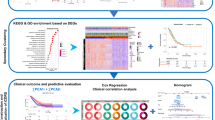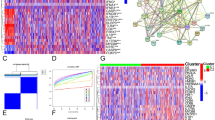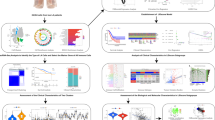Abstract
Purpose
Immunogenic cell death (ICD) is a type of regulated cell death (RCD) which was discovered to activate adaptive immunity. To date, the effect of ICD on lung adenocarcinoma (LUAD) remains unclear. In this research, we will study the role of ICD-related genes (ICDG) in LUAD.
Methods
RNA sequencing and clinical data were gathered from TCGA-LUAD cohorts and GEO database. Using unsupervised cluster analysis, three clusters were identified with distinctive immune characteristics and significant overall survival based on 18 ICDG. Using LASSO Cox regression, three genes were identified and used to construct the prognosis signature. The association between the 3-ICDG risk signature and immune microenvironment analysis, somatic mutation, and enriched molecular pathways was investigated.
Results
Consensus clustering separated the LUAD samples into three clusters (ICDcluster A, B and C), and ICDcluster B had the best prognosis. Different TME cell infiltration characteristics and biological behavior were found in three ICD clusters. Prognostic risk model was contrasted based on the 3 best prognostic ICD-related genes. Subsequently, vitro experiments verified the above analysis results. The high-risk group showed a poor prognosis and enrichment of cancer promoting signal pathway. Multivariate analysis indicated that this 3-ICDG prognostic model might be an accurate prediction parameter for LUAD. Moreover, conducting immune related analysis, we found that the 3-ICDG risk signature was characterized by an immune-active subtype on account of the high infiltration of immune-active cells.
Conclusion
This study expands our cognition of ICD in LUAD microenvironment, excavated prognostic biomarkers, and provided potential value for guiding immunotherapy and chemotherapy.










Similar content being viewed by others
Availability of data and materials
Not applicable.
References
Ahmed A, Tait SWG (2020) Targeting immunogenic cell death in cancer. Mol Oncol 14(12):2994–3006. https://doi.org/10.1002/1878-0261.12851
Aldarouish M, Wang C (2016) Trends and advances in tumor immunology and lung cancer immunotherapy. J Exp Clin Cancer Res 35(1):157. https://doi.org/10.1186/s13046-016-0439-3
Aluri J, Cooper MA, Schuettpelz LG (2021) Toll-like receptor signaling in the establishment and function of the immune system. Cells. https://doi.org/10.3390/cells10061374
Balachandran VP, Gonen M, Smith JJ, DeMatteo RP (2015) Nomograms in oncology: more than meets the eye. Lancet Oncol 16(4):e173-180. https://doi.org/10.1016/S1470-2045(14)71116-7
Barta JA, Powell CA, Wisnivesky JP (2019) Global epidemiology of lung cancer. Ann Glob Health. https://doi.org/10.5334/aogh.2419
Cassim S, Chepulis L, Keenan R, Kidd J, Firth M, Lawrenson R (2019) Patient and carer perceived barriers to early presentation and diagnosis of lung cancer: a systematic review. BMC Cancer 19(1):25. https://doi.org/10.1186/s12885-018-5169-9
Chan TA, Yarchoan M, Jaffee E, Swanton C, Quezada SA, Stenzinger A, Peters S (2019) Development of tumor mutation burden as an immunotherapy biomarker: utility for the oncology clinic. Ann Oncol 30(1):44–56. https://doi.org/10.1093/annonc/mdy495
Davis BP, Rothenberg ME (2014) Eosinophils and cancer. Cancer Immunol Res 2(1):1–8. https://doi.org/10.1158/2326-6066.CIR-13-0196
Duan X, Chan C, Lin W (2019) Nanoparticle-mediated immunogenic cell death enables and potentiates cancer immunotherapy. Angew Chem Int Ed Engl 58(3):670–680. https://doi.org/10.1002/anie.201804882
Fukushima H, Yoshida S, Kijima T, Nakamura Y, Fukuda S, Uehara S et al (2021) Combination of cisplatin and irradiation induces immunogenic cell death and potentiates postirradiation anti-PD-1 treatment efficacy in urothelial carcinoma. Int J Mol Sci. https://doi.org/10.3390/ijms22020535
Galluzzi L, Vitale I, Aaronson SA, Abrams JM, Adam D, Agostinis P et al (2018) Molecular mechanisms of cell death: recommendations of the Nomenclature Committee on Cell Death 2018. Cell Death Differ 25(3):486–541. https://doi.org/10.1038/s41418-017-0012-4
Galluzzi L, Humeau J, Buque A, Zitvogel L, Kroemer G (2020a) Immunostimulation with chemotherapy in the era of immune checkpoint inhibitors. Nat Rev Clin Oncol 17(12):725–741. https://doi.org/10.1038/s41571-020-0413-z
Galluzzi L, Vitale I, Warren S, Adjemian S, Agostinis P, Martinez AB et al (2020b) Consensus guidelines for the definition, detection and interpretation of immunogenic cell death. J Immunother Cancer. https://doi.org/10.1136/jitc-2019-000337
Garg AD, De Ruysscher D, Agostinis P (2016) Immunological metagene signatures derived from immunogenic cancer cell death associate with improved survival of patients with lung, breast or ovarian malignancies: a large-scale meta-analysis. Oncoimmunology 5(2):e1069938. https://doi.org/10.1080/2162402X.2015.1069938
Hanzelmann S, Castelo R, Guinney J (2013) GSVA: gene set variation analysis for microarray and RNA-seq data. BMC Bioinform 14:7. https://doi.org/10.1186/1471-2105-14-7
Herbst RS, Morgensztern D, Boshoff C (2018) The biology and management of non-small cell lung cancer. Nature 553(7689):446–454. https://doi.org/10.1038/nature25183
Hirsch FR, Scagliotti GV, Mulshine JL, Kwon R, Curran WJ Jr, Wu YL, Paz-Ares L (2017) Lung cancer: current therapies and new targeted treatments. Lancet 389(10066):299–311. https://doi.org/10.1016/S0140-6736(16)30958-8
Islami F, Ward EM, Sung H, Cronin KA, Tangka FKL, Sherman RL et al (2021) Annual report to the Nation on the status of cancer, Part 1: National Cancer Statistics. J Natl Cancer Inst. https://doi.org/10.1093/jnci/djab131
Klempner SJ, Fabrizio D, Bane S, Reinhart M, Peoples T, Ali SM et al (2020) Tumor mutational burden as a predictive biomarker for response to immune checkpoint inhibitors: a review of current evidence. Oncologist 25(1):e147–e159. https://doi.org/10.1634/theoncologist.2019-0244
Krysko DV, Garg AD, Kaczmarek A, Krysko O, Agostinis P, Vandenabeele P (2012) Immunogenic cell death and DAMPs in cancer therapy. Nat Rev Cancer 12(12):860–875. https://doi.org/10.1038/nrc3380
Liu P, Zhao L, Pol J, Levesque S, Petrazzuolo A, Pfirschke C et al (2019) Crizotinib-induced immunogenic cell death in non-small cell lung cancer. Nat Commun 10(1):1486. https://doi.org/10.1038/s41467-019-09415-3
Ma QY, Huang DY, Zhang HJ, Chen J, Miller W, Chen XF (2016) Function of follicular helper T cell is impaired and correlates with survival time in non-small cell lung cancer. Int Immunopharmacol 41:1–7. https://doi.org/10.1016/j.intimp.2016.10.014
Mandrekar JN (2010) Receiver operating characteristic curve in diagnostic test assessment. J Thorac Oncol 5(9):1315–1316. https://doi.org/10.1097/JTO.0b013e3181ec173d
Mitchell D, Chintala S, Dey M (2018) Plasmacytoid dendritic cell in immunity and cancer. J Neuroimmunol 322:63–73. https://doi.org/10.1016/j.jneuroim.2018.06.012
Newick K, O’Brien S, Moon E, Albelda SM (2017) CAR T cell therapy for solid tumors. Annu Rev Med 68:139–152. https://doi.org/10.1146/annurev-med-062315-120245
Nguyen TT, Shin DH, Sohoni S, Singh SK, Rivera-Molina Y, Jiang H et al (2022) Reshaping the tumor microenvironment with oncolytic viruses, positive regulation of the immune synapse, and blockade of the immunosuppressive oncometabolic circuitry. J Immunother Cancer. https://doi.org/10.1136/jitc-2022-004935
O’Shea JJ, Plenge R (2012) JAK and STAT signaling molecules in immunoregulation and immune-mediated disease. Immunity 36(4):542–550. https://doi.org/10.1016/j.immuni.2012.03.014
Rose PG, Java J, Whitney CW, Stehman FB, Lanciano R, Thomas GM, DiSilvestro PA (2015) Nomograms predicting progression-free survival, overall survival, and pelvic recurrence in locally advanced cervical cancer developed from an analysis of identifiable prognostic factors in patients from NRG Oncology/Gynecologic Oncology Group randomized trials of chemoradiotherapy. J Clin Oncol 33(19):2136–2142. https://doi.org/10.1200/JCO.2014.57.7122
Sha D, Jin Z, Budczies J, Kluck K, Stenzinger A, Sinicrope FA (2020) Tumor mutational burden as a predictive biomarker in solid tumors. Cancer Discov 10(12):1808–1825. https://doi.org/10.1158/2159-8290.CD-20-0522
Siegel RL, Miller KD, Fuchs HE, Jemal A (2022) Cancer statistics, 2022. CA Cancer J Clin 72(1):7–33. https://doi.org/10.3322/caac.21708
Solari JIG, Filippi-Chiela E, Pilar ES, Nunes V, Gonzalez EA, Figueiro F et al (2020) Damage-associated molecular patterns (DAMPs) related to immunogenic cell death are differentially triggered by clinically relevant chemotherapeutics in lung adenocarcinoma cells. BMC Cancer 20(1):474. https://doi.org/10.1186/s12885-020-06964-5
Song J, Sun Y, Cao H, Liu Z, Xi L, Dong C et al (2021) A novel pyroptosis-related lncRNA signature for prognostic prediction in patients with lung adenocarcinoma. Bioengineered 12(1):5932–5949. https://doi.org/10.1080/21655979.2021.1972078
Sung H, Ferlay J, Siegel RL, Laversanne M, Soerjomataram I, Jemal A, Bray F (2021) Global cancer statistics 2020: GLOBOCAN estimates of incidence and mortality worldwide for 36 cancers in 185 countries. CA Cancer J Clin 71(3):209–249. https://doi.org/10.3322/caac.21660
Tokunaga R, Naseem M, Lo JH, Battaglin F, Soni S, Puccini A et al (2019) B cell and B cell-related pathways for novel cancer treatments. Cancer Treat Rev 73:10–19. https://doi.org/10.1016/j.ctrv.2018.12.001
Voloshin T, Kaynan N, Davidi S, Porat Y, Shteingauz A, Schneiderman RS et al (2020) Tumor-treating fields (TTFields) induce immunogenic cell death resulting in enhanced antitumor efficacy when combined with anti-PD-1 therapy. Cancer Immunol Immunother 69(7):1191–1204. https://doi.org/10.1007/s00262-020-02534-7
Wang X, Li M (2019) Correlate tumor mutation burden with immune signatures in human cancers. BMC Immunol 20(1):4. https://doi.org/10.1186/s12865-018-0285-5
Yang D, Liu Y, Bai C, Wang X, Powell CA (2020a) Epidemiology of lung cancer and lung cancer screening programs in China and the United States. Cancer Lett 468:82–87. https://doi.org/10.1016/j.canlet.2019.10.009
Yang W, Zhang F, Deng H, Lin L, Wang S, Kang F et al (2020b) Smart nanovesicle-mediated immunogenic cell death through tumor microenvironment modulation for effective photodynamic immunotherapy. ACS Nano 14(1):620–631. https://doi.org/10.1021/acsnano.9b07212
Yatim N, Cullen S, Albert ML (2017) Dying cells actively regulate adaptive immune responses. Nat Rev Immunol 17(4):262–275. https://doi.org/10.1038/nri.2017.9
Zhou J, Wang G, Chen Y, Wang H, Hua Y, Cai Z (2019) Immunogenic cell death in cancer therapy: present and emerging inducers. J Cell Mol Med 23(8):4854–4865. https://doi.org/10.1111/jcmm.14356
Acknowledgements
Not applicable.
Funding
This work was supported by the “Six-one” Project for High-level Health Talents (LGY2016037), Nantong Key Laboratory of Translational Medicine in Cardiothoracic Diseases, Nantong Clinical Medical Research Center of Cardiothoracic Disease, and Institution of Translational Medicine in Cardiothoracic Diseases in Affiliated Hospital of Nantong University.
Author information
Authors and Affiliations
Contributions
QL, YT, and TW: contributed equally to this work. Study concept and design: JS and YZ; data collection and processing: QL, TW and JZ; technical and material support: QL, YT and TW; experiment implementation and date analysis: QL, YT, TW and JZ; paper writing: QL and YT; funding support and study supervision: JS and YZ. All authors contributed to the study and approved the final manuscript.
Corresponding authors
Ethics declarations
Conflict of interest
The authors declare that they have no competing interests.
Ethics approval and consent to participate
This study was approved by the Ethics Committee of the Affiliated Hospital of Nantong University (No. S20200314-012).
Additional information
Publisher's Note
Springer Nature remains neutral with regard to jurisdictional claims in published maps and institutional affiliations.
Supplementary Information
Below is the link to the electronic supplementary material.

432_2022_4555_MOESM1_ESM.jpg
Supplementary file1Supplementary Fig. 1. KM curves of OS regarding different clinical features. KM, Kaplan–Meier; OS, overall survival (JPG 1125 KB)
Rights and permissions
Springer Nature or its licensor (e.g. a society or other partner) holds exclusive rights to this article under a publishing agreement with the author(s) or other rightsholder(s); author self-archiving of the accepted manuscript version of this article is solely governed by the terms of such publishing agreement and applicable law.
About this article
Cite this article
Li, Q., Tang, Y., Wang, T. et al. Novel immunogenic cell death-related risk signature to predict prognosis and immune microenvironment in lung adenocarcinoma. J Cancer Res Clin Oncol 149, 307–323 (2023). https://doi.org/10.1007/s00432-022-04555-4
Received:
Accepted:
Published:
Issue Date:
DOI: https://doi.org/10.1007/s00432-022-04555-4




